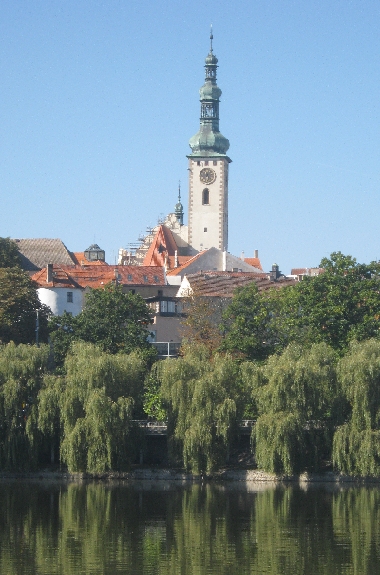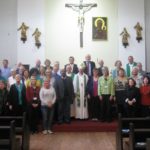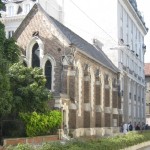
As part of my two weeks of annual leave following my return from the Eastern Archdeaconry Synod in Bucharest, Sybille and I spent a long weekend at the beginning of October, staying in Tábor, exploring this fascinating historical town and parts of the surrounding area of South Bohemia. During the whole time we were there, we were blessed by some wonderful ‘Indian Summer’ weather as can be seen in the accompanying photographs featuring very clear blue skies.
Tábor lies about 100 kilometres south-east of Prague and it took us less than two hours to drive there. After walking around the historic centre of the town, we eventually found excellent accommodation in Penzion Modrá ruže which has a gated back yard where we were able to securely park the car.
The historic centre of Tábor is perched on a steep hillside overlooking the Lužnice River and is surrounded on three sides by precipitous wooded slopes. In the fourteenth century, a castle was built here though all that remains of it is the Kotnov Tower by the west town gate which can be seen in my photo accompanying an earlier post.
Tábor proper was founded by the radical followers of Jan Hus in 1420, five years after he was burnt at the stake in Konstanz. The town was named after the Biblical Mount Tábor (Psalm 89. 12) which is thought by some to also be the mountain on which Jesus was transfigured. The Hussites sought to organise the town following the example of the very early Christian believers by holding everything in common ownership as described in Acts 2. 44-45. They joined together in communal work to build the town and its defences and it is often suggested that this extreme variety of nonconformity is what has given rise to the connotations we now associate with the word ‘Bohemian’.

Despite its defensive site, the forces of the radical Hussites of Tábor were eventually defeated at the Battle of Lipany in 1434 and thereafter, the significance of the town declined. Fortunately, much of the wonderful architecture of the period has survived.
These two photographs are of buildings that surround Žižkovo námestí, the main central square in Tábor, named after the Hussite leader Jan Žižka. Unfortunately, the Hussite Museum, having been closed for stocktaking the two days before we arrived, did not re-open at the weekend as according to its own website, it should have done. Instead, it was scheduled to re-open on Wednesday 5th October, the day after we left Tábor to return to Prague. However, not being able to visit it does give me a good excuse to re-visit Tábor some time in the future.

Tábor also features many buildings with sgraffito decoration. However, I did find it a little incongruous that that this wonderfully beautiful ancient building was now being used as a fast-food outlet!


In the more modern part of Tábor, to the east of the historic centre, I came across two examples of things I’ve previously written about in this blog. The photograph on the left is of a memorial commemorating the liberation of Czechoslovakia, (as it was then), from the occupying Nazi forces. It is a typical example of communist era architecture showing a Soviet soldier, machine gun over his shoulder, lifting a child into the air. Underneath is the correct date of the end of the Second World War, 8th May 1945. But as I explained in my earlier post entitled ‘Correcting History’, because the Nazi surrender was signed late in the evening of 8th May 1945, it was already after midnight in Moscow, thus meaning that the former Soviet Union and its satellite states, always celebrated VE Day (Victory in Europe Day) on 9th May each year.
Since the Velvet Revolution of 1989, VE Day is now celebrated and marked with a public holiday, on 8th May each year in the Czech Republic. If you look closely at the inscription in the second photograph, it is quite clear that the ‘8’ is far newer and shinier than the rest of the lettering. No doubt it replaced a previous ‘9’! Likewise, because this is a memorial erected in the Communist era, it originally featured the hammer and sickle emblem. This was clearly removed at some point after 1989 but, an outline of where it once was, can still clearly be seen on the stone work above the date.

Finally, despite promising not to feature anymore examples of Czenglish, or ‘bad English’ as one of my fellow cricketers thinks I should call it, I cannot help but post this photograph of a sign in Tábor that had Sybille & I in fits of laughter. Bearing in mind that Tábor is not so far from the Austrian border and German speaking visitors are quite numerous, it appears to be an advertisement in German for a ‘Nothing Club’!





Gosh, how did I manage to miss this? A very interesting post with lovely photos of gorgeous architecture. No wonder you enjoyed your weekend there so much, Ricky.
Hi Perpetua – as one of my most faithful commenters, I did wonder where you’d been 🙂 Yes – Tábor is both architecturally and historically interesting & we were blessed by some wonderful weather for our visit. We did also visit the neighbouring little town of Bechyne which I hope to feature in another post soon.